
Jacob de Wit was a Dutch artist and interior decorator who painted many religious scenes.

Philip Fruytiers (1610–1666) was a Flemish Baroque painter and engraver. Until the 1960s, he was especially known for his miniature portraits in watercolor and gouache. Since then, several large canvases signed with the monogram PHF have been ascribed to him. These new findings have led to a renewed appreciation for his contribution to the Antwerp Baroque.

St. James' Church is a former collegiate church in Antwerp, Belgium. The church is built on the site of a hostel for pilgrims to Santiago de Compostela. The present building is the work of the Waghemakere family and Rombout Keldermans, in Brabantine Gothic style. The church contains the grave of Peter Paul Rubens in the eastern chapel.
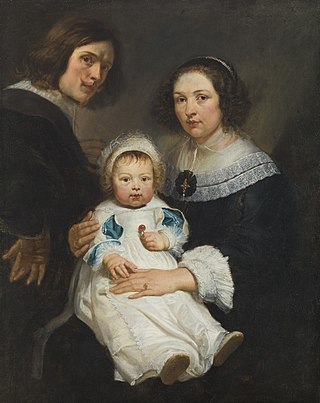
Erasmus Quellinus the Younger or Erasmus Quellinus II (1607–1678) was a Flemish painter, engraver, draughtsman and tapestry designer who worked in various genres including history, portrait, allegorical, battle and animal paintings. He was a pupil of Peter Paul Rubens and one of the closest collaborators of Rubens in the 1630s. Following Rubens' death in 1640 he became one of the most successful painters in Flanders. He was a prolific draughtsman who made designs for decorative programmes in the context of official celebrations, for publications by the local publishers and for tapestries and sculptures realised by the local workshops. His work reveals the Classicist trend in the Baroque.

Flemish Baroque painting was a style of painting in the Southern Netherlands during Spanish control in the 16th and 17th centuries. The period roughly begins when the Dutch Republic was split from the Habsburg Spain regions to the south with the Spanish recapturing of Antwerp in 1585 and goes until about 1700, when Spanish Habsburg authority ended with the death of King Charles II. Antwerp, home to the prominent artists Peter Paul Rubens, Anthony van Dyck, and Jacob Jordaens, was the artistic nexus, while other notable cities include Brussels and Ghent.
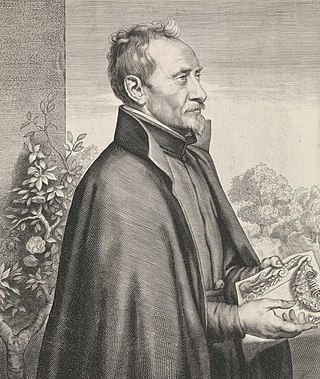
Daniël Seghers or Daniel Seghers was a Flemish Jesuit brother and painter who specialized in flower still lifes. He is particularly well known for his contributions to the genre of flower garland painting. His paintings were collected enthusiastically by aristocratic patrons and he had numerous followers and imitators.

Gerard Seghers was a Flemish painter, art collector, and art dealer. After a period of study and residence in Italy, he returned to Flanders where he became one of the leading representatives of the Flemish Caravaggisti movement. In his later career he abandoned the Caravaggist style and genre motifs to become an important painter of large altarpieces for local churches.

Sir Peter Paul Rubens was a Flemish artist and diplomat from the Duchy of Brabant in the Southern Netherlands. He is considered the most influential artist of the Flemish Baroque tradition. Rubens's highly charged compositions reference erudite aspects of classical and Christian history. His unique and immensely popular Baroque style emphasized movement, colour, and sensuality, which followed the immediate, dramatic artistic style promoted in the Counter-Reformation. Rubens was a painter producing altarpieces, portraits, landscapes, and history paintings of mythological and allegorical subjects. He was also a prolific designer of cartoons for the Flemish tapestry workshops and of frontispieces for the publishers in Antwerp.

Charles Emmanuel Biset or Karel Emmanuel Biset was a Flemish painter who had a peripatetic career working in various cities and countries including his hometown Mechelen, Paris, Annonay, Brussels, Antwerp and Breda. He worked in many genres including genre scenes of interiors with merry companies and gallery paintings, history painting, still life and portraiture.
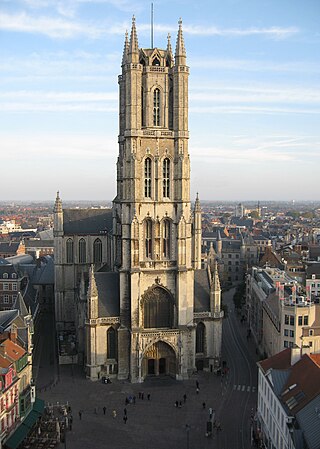
Saint Bavo's Cathedral, also known as Sint-Baafs Cathedral, is a cathedral of the Catholic Church in Ghent, Belgium. The 89-meter-tall Gothic building is the seat of the Diocese of Ghent and is named for Saint Bavo of Ghent. It contains the well-known Ghent Altarpiece.

Wilhelm Schubert van Ehrenberg or Willem Schubart van Ehrenberg (also: Wilhem Schubert von Ehrenberg or Wilhem Schubert van Ehrenberg was a Flemish painter mainly active in Antwerp who specialized in architectural paintings including of real and imaginary church interiors, Renaissance palaces and picture galleries.
Pieter Huyssens was a Flemish Jesuit brother and Baroque architect.

Gaspar Peeter Verbruggen the Elder was a Flemish painter of flowers and garland paintings.

St. Paul's Church is a Roman Catholic church located at the Veemarkt in Antwerp, Belgium. Its exterior is mainly Gothic with a Baroque tower while the interior is characterised by its rich Baroque decoration. It holds paintings by Antwerp's leading artists Peter Paul Rubens, Anthony van Dyck and Jacob Jordaens as well as abundant sculpture and church furniture crafted by leading Antwerp sculptors such as Artus Quellinus the Elder, Pieter Verbrugghen I, Jan Pieter van Baurscheit de Elder, Jan Claudius de Cock and Andries Colyns de Nole. Of particular note is the Calvary outside the Church which is made up of 63 life-size statues and nine reliefs executed in a popular and theatrical style.

Jan Punt, was an 18th-century painter from the Northern Netherlands.

Pieter-Jozef Verhaghen was a Flemish painter of large-scale religious and mythological scenes. He is regarded as the last representative of the so-called Flemish School of painting. In particular, he is seen as continuing the artistic tradition of Flemish Baroque painting as exemplified by Rubens in the late 18th century and into the 19th century. He was highly regarded during his lifetime and enjoyed the patronage of eminent patrons and religious institutions. He was appointed first court painter to Empress Maria Theresa of Austria who also provided him a stipend to travel abroad to further his artistic studies.

Jan Carel Vierpeyl or Jan Carel Vierpyl was a Flemish painter known mainly for his family portraits and genre scenes of merry and gallant companies.

Jacob Balthasar Peeters, also known as Jacob Peeters or Jacobus Peeters was a Flemish painter who specialized in architectural paintings depicting imaginary Renaissance and Baroque palaces populated with elegant figures wearing exotic clothes and headgear and shown in theatrical, stage-like postures. Peeters also painted realistic interiors of existing churches with staffage.
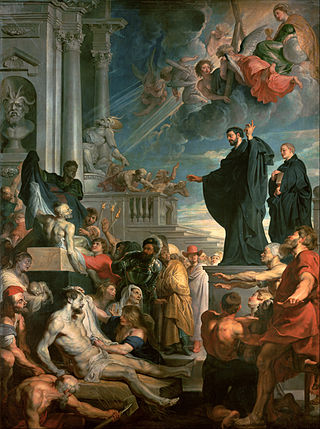
The Miracles of St. Francis Xavier is a large altarpiece painted by Peter Paul Rubens in 1617 or 1618. It was originally commissioned by the Jesuits in Antwerp for their church, now known as the St. Charles Borromeo Church. It is now in the Kunsthistorisches Museum in Vienna. The painting depicts the miracles worked by St. Francis Xavier during his mission to Asia and includes a large variety of figures from Asia and Africa, as well as the destruction of a Hindu idol in the background. Rubens also painted a companion piece, The Miracles of St. Ignatius of Loyola.
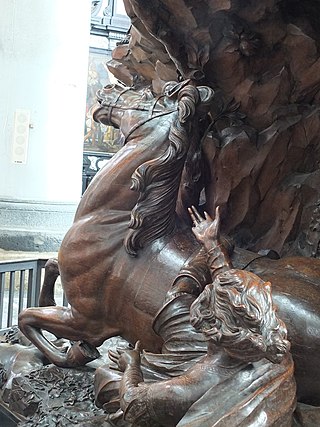
Michiel van der Voort the Elder, Michiel van der Voort (I) or Michiel Vervoort the Elder, nickname Welgemaeckt (Antwerp, 3 January 1667 – Antwerp, buried on 8 December 1737) was a Flemish sculptor and draftsman, who is best known for the Baroque church furniture which he made for the principal churches in Flanders. He also produced secular works, particularly of mythological and allegorical subjects. His work expresses both late Baroque exuberance and the quest for the simplicity of Classicism. His oeuvre shows the influence of Michelangelo, François Duquesnoy and Rubens. He trained many members of the next generation of Flemish sculptors.






























